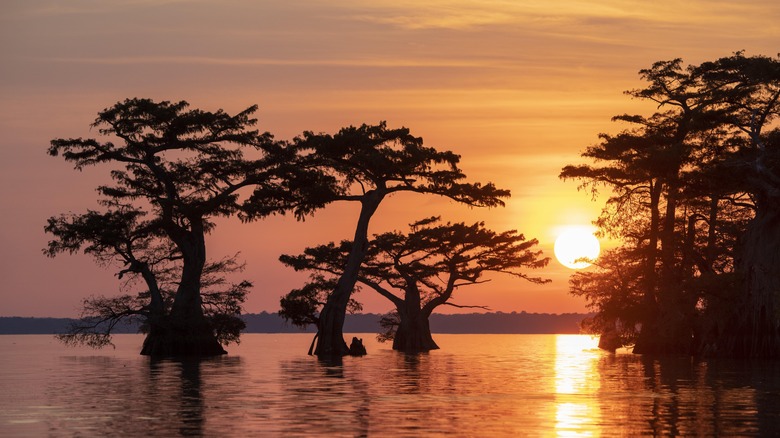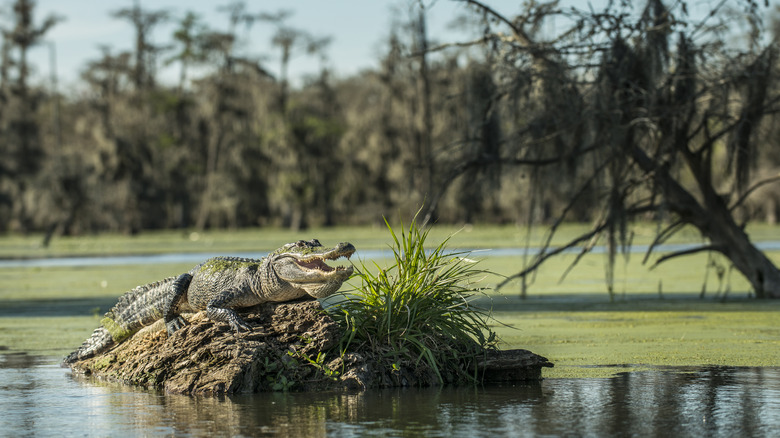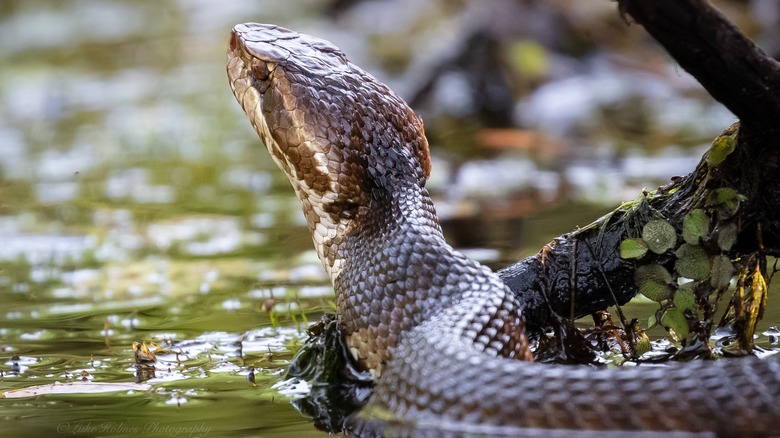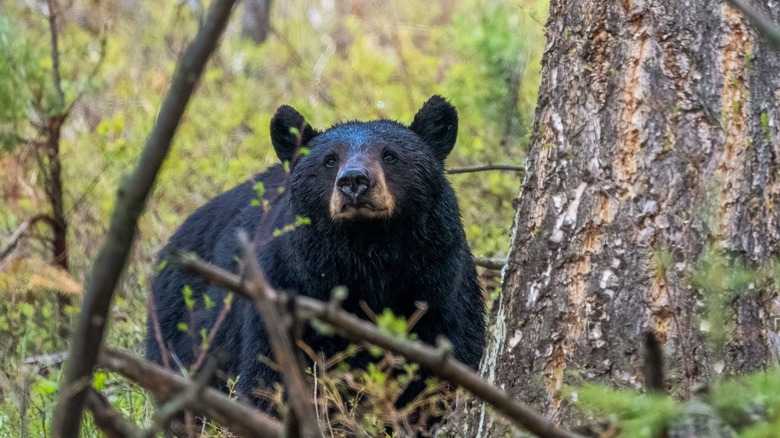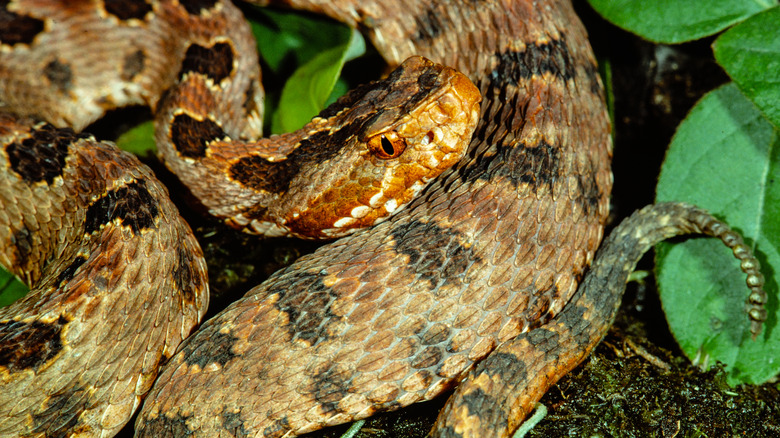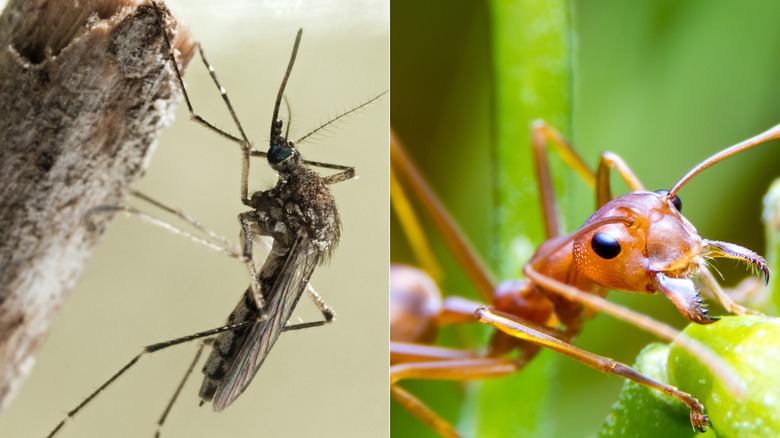Creatures To Beware Of When Adventuring In Louisiana's Atchafalaya Basin
Louisiana is known as the Sportsman's Paradise. It even says so on its residents' vehicle license plates. This nickname derives from the amount of wildlife, natural features, and outdoor recreational opportunities found within the state. Southern Louisiana's Atchafalaya River Basin embodies the true essence of the Sportsman's Paradise nickname. Although the Atchafalaya River is relatively short as rivers go, stretching only 140 miles, it drains a considerable portion of the Southern United States. Additionally, the surrounding lowlands make up the largest river floodplain swamp in North America, covering nearly a million acres.
The Atchafalaya Basin is renowned for its natural beauty and the extraordinary flora and fauna found there. Many travelers only catch a glimpse of the swampy basin while crossing the Atchafalaya Basin Bridge, an 18-mile stretch of Interstate 10 that was once the longest bridge in the United States. Those wishing to explore this remarkable wetlands area further will find ample public access.
The National Park Service maintains the Atchafalaya National Heritage Area, which includes the largest swamp in the United States, while the U.S. Fish & Wildlife Service operates the Atchafalaya National Wildlife Refuge in the region. Those federal areas, along with a handful of state and local parks, give visitors ample access to the Atchafalaya Basin for hiking, paddling, fishing, and other outdoor adventures. However, there are a number of dangerous creatures people should beware of when adventuring in the Atchafalaya River Basin, including two of the most dangerous types of snakes in the world.
Alligators are kings of the swamp
Although it is found in all of the Gulf Coast states, the alligator is practically synonymous with Louisiana –- so much so that the American alligator was named the official state reptile in 1983. The History Channel has been chronicling the trials and tribulations of alligator hunters in Southern Louisiana for over 15 seasons on its popular reality show, "Swamp People." While some outdoor trekkers hope to avoid gator-infested waters, others are drawn to them. For those hoping to catch a glimpse of an American alligator firsthand, the Atchafalaya River Basin is one of the very best places to explore.
Regardless of whether you are hoping to find or avoid alligators while visiting the Atchafalaya River Basin, there are a few tips you need to follow to stay safe from them during an adventure in the swamp. For starters, alligators are most active and tend to hunt along the water's edge at night and during lowlight periods. Avoid being in the water or near the shoreline at these times. You should always keep pets and children away from the edge of the water. Do not feed alligators or throw food into the water. If you are cleaning fish, do not throw the entrails and other discarded parts into the water. Never try to pick up an alligator egg, hatchling, or touch an alligator of any size. You should be extra cautious during spring when alligators are mating and more aggressive.
Water moccasins are semi-aquatic serpents
Water moccasins hold the distinction of being the only venomous water snake in North America. They are common sights in the Atchafalaya River Basin, as are water snakes, which are not venomous. The two are often confused with one another, as both reptiles display a variety of colors and patterns ranging from brown to black, so it is of utmost importance that anyone adventuring in the swamp knows the signs of a venomous snake. In the case of the water moccasin, also known as the cottonmouth for its penchant for opening wide to display the cottony white inside of its mouth when it feels threatened, it has all the traits of a pit viper: triangular-shaped head, slit-like pupils, and facial pits.
As their name suggests, water moccasins are commonly found in the water. However, since they are semiaquatic, they also spend plenty of time on land. Thus, hikers and campers need to be aware of where they step, as well as keep an eye on the water to avoid encountering a moccasin. When not in the water, these snakes will usually be coiled up along the shorelines, on logs in the water, next to logs on damp ground, and sometimes in low-hanging branches near or over the water. In addition to showing the white of their mouth, water moccasins also sometimes emit a pungent spray as a warning.
Louisiana black bears are becoming common
Many people may not consider swampland to be a typical black bear habitat. However, they'd be wrong. The Louisiana black bear, a subspecies of the American black bear, was a common sight throughout all of Louisiana during the 1800s and early 1900s. They were so numerous, particularly in the Atchafalaya River Basin, that they were considered a nuisance. By 1992, however, the population had dropped so significantly that it was placed on the endangered species list. With federal protections in place and substantial local and state conservation efforts, their number began to increase once again. In 2016, the Louisiana black bear was removed from the endangered species list, thanks largely to the growth of their population in the Atchafalaya River Basin.
To that end, it is no longer considered out of the ordinary to come across a bear while adventuring in the Atchafalaya River Basin. Avoiding bear encounters in Louisiana requires the same protocol as anywhere else bears are known to live. While they are considered a dangerous type of bear, Louisiana black bears, like all black bears, tend to be shy and often avoid humans. So, when moving through the woods, make enough noise to alert them to your presence. Don't leave food out at your campsite, and if you see a bear, do not attempt to feed or get closer to it. However, if a bear approaches you, attempt to scare it away by making as much noise as possible.
Other venomous snakes roam the Atchafalaya Basin
Water moccasins may be the most common venomous snake in the Atchafalaya River Basin, but they are hardly the only ones. Pygmy rattlesnakes are known to be along the western edge of the basin. As their names suggest, they are quite small –- less than 2 feet maximum length. However, they are venomous nonetheless. Another larger rattlesnake is also present in portions of the Atchafalaya Basin. That snake is the timber rattlesnake, also known as the canebrake rattlesnake, which is capable of growing to nearly 6 feet in length. Finally, the eastern copperhead is also present in portions of the area. Copperheads are much more common than either of the rattlers.
While each of these three snakes is similar in appearance to some of the non-venomous snakes in the Atchafalaya Basin, like the moccasin, they are pit vipers and have nostril pits, slit-like eyes, and large triangular heads. So, what should you do if you run into a rattlesnake while hiking in the Atchafalaya Basin, or a copperhead or moccasin, for that matter? Give it plenty of room and move slowly away while keeping your eyes on it. Under no circumstances should you attempt to hold or handle a snake while adventuring in the Atchafalaya Basin, regardless of whether you believe it to be venomous or not.
Mosquitoes and fire ants sting and bite
Although they are two of the smaller creatures inhabiting the nearly one million acres of bottomland in the Atchafalaya River Basin, mosquitoes and fire ants can present some of the biggest problems for those adventuring there. Mosquitoes themselves present several problems. For starters, as everyone who has ever stepped outside is aware, they can deliver a very unpleasant sting. In addition to causing discomfort, these diminutive bloodsuckers are also capable of transmitting a number of diseases, including St. Louis encephalitis, West Nile virus, Zika virus, malaria, yellow fever, and more. As one may expect, the largest swampland in North America is home to an impressive mosquito population, with nearly six dozen species being represented. So, it is vital you arrive for your adventure armed with some sort of soothing-scented mosquito repellent.
Fire ants are considered one of the most dangerous ants for their ability to both bite and sting. These fierce insects also tend to attack en masse, leaving the victim with dozens of painful bumps at best and a severe allergic reaction at worst. It is important to watch where you step, sit, or place your hands and belongings so as not to land on a colony of fire ants. It is a good idea when adventuring in the Atchafalaya Basin to include an antihistamine to help manage any reaction to ant bite incidents. It is also important to monitor someone after they are bitten to make sure they don't have a severe reaction.
